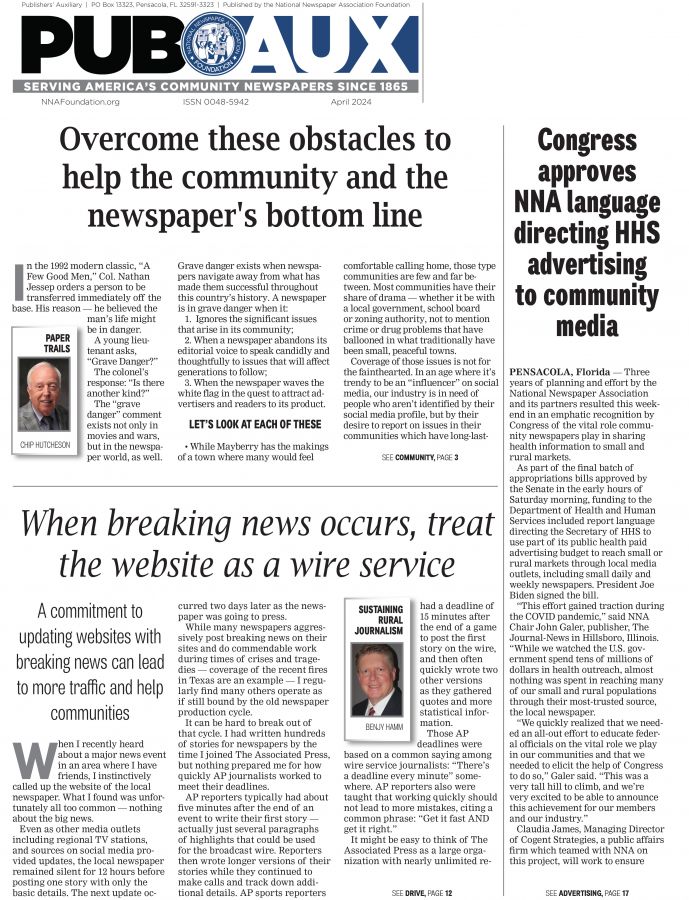Broaden the definition of big projects
Mar 13, 2017
By Jim Pumarlo
Everyday Ethics
Strike up a newsroom conversation about big projects, and the mind-set often focuses on an in-depth series that can take weeks to research and write, and then will be published over multiple days. Newsrooms should strive to do those projects, even if it’s done only once a year.
But big projects also can mean generating more substantive reports in your everyday coverage. In other words, look for opportunities beyond the spot news. Take time to brainstorm stories on both fronts.
Ideas to expand your
ongoing coverage
Annual reports are routinely presented at meetings of local government bodies—everything from a wrap-up of parent advisory council activities to building permits to public safety. Review these reports for the most compelling statistics. Highlight those in a story, accompanied by a sidebar with the overall statistics. The reports may prompt follow-up coverage.
Election campaigns are an exhaustive, months-long process. Identify stories beyond your normal coverage. For example, have a candidate keep a diary. Examine campaign contributions. Profile the inner workings of a campaign committee; check in with a first-time candidate and an incumbent.
Pay attention to second-day stories that look beneath the surface of the circumstances. Broaden the conversation with individuals beyond those associated with the original news event. These stories are also a great way to distinguish your coverage from that of “outside” media. This follow-up is especially worthwhile and effective when reporting on sensitive and challenging stories that may prompt charges of sensational coverage.
Expand your definition of business news beyond store openings and anniversaries, new hires and labor disputes. Jobs consume a great deal of people’s lives. A variety of workplace stories about employers and employees can be pursued that is both substantive and interesting.
High school graduations are among the numerous stories written year after year. Research and find a distinctive fact about each senior class in your readership area and produce a feature. A class may be distinguished by academic and/or athletic accomplishments. Profile a student who has overcome personal challenges, or a class with an unusually high number of twins.
Ideas for special projects
Chronicle a day in the life of your community. Think beyond the newsroom to find individuals to help record 24 hours in your community through words and photos on all your platforms. Enlist staff from other departments, as well as community members.
Produce a summer guide of fun things to do in your readership area. Reporters can take turns writing this weekly feature.
Profile individuals who are not regularly in the news. Scan any batch of your newspapers, and it’s a good bet that many of the same names and faces appear on your pages. Introduce individuals who are not your traditional newsmakers but are no less noteworthy or interesting, for one reason or another. The profile can be used to localize a state or national story.
Set an agenda for the community in your first editorial in January, identifying a handful of key projects or a theme that your newspaper will emphasize during the year. Then produce news/editorial packages to advance the theme.
Be sure to approach special projects in a collaborative effort. Brainstorm projects as a team; get story ideas from everyone. Those who suggest a good idea should get first dibs on the story, but they don’t have to do it either. © Jim Pumarlo 2017
Jim Pumarlo writes, speaks and provides training on community newsroom success strategies. He is author of “Journalism Primer: A Guide to Community News Coverage,” “Votes and Quotes: A Guide to Outstanding Election Coverage” and “Bad News and Good Judgment: A Guide to Reporting on Sensitive Issues in Small-Town Newspapers.” He can be reached at www.pumarlo.com and welcomes comments and questions at jim@pumarlo.com.







